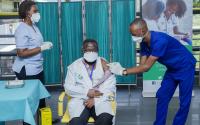[ad_1]
Table of Contents
Convalescent plasma associated with lower COVID-19 death rates
Hospitalized COVID-19 patients in a Warsaw, Poland, hospital had a significantly lower mortality rate when treated with convalescent plasma, especially early, according to a study published yesterday in the International Journal of Infectious Diseases.
The researchers used propensity score matching to pair a control group with 102 hospitalized COVID patients who received one, two, or three 200-milliliter doses of convalescent plasma starting within 14 days of diagnosis. The study ran from Apr 24 to Sep 28, 2020. Less than 2% of patients in the whole study cohort did not have any comorbidities.
The researchers found that those who received convalescent plasma had a 13.7% mortality rate, compared with 34.3% in those who didn’t (P = 0.001). Age, cardiac issues, cancer, length of hospital stay, and ventilator requirement were all associated with greater mortality risk. Receiving convalescent plasma sooner in disease progression was associated with lower cumulative incidence of death.
The need for respiratory treatment was also lower in the treatment group (11.8% vs 21.6%), although the researchers note this is not statistically significant. SARS-CoV-2 elimination time, respirator time, intensive care unit stay, and hospital stay also did not show significance, although the latter was longer for those in the convalescent plasma group (median 20 days vs 13 days). The researchers say this could be due to the high mortality in the control group or the effects of receiving multiple doses of plasma.
“Convalescent plasma transfusion seems to be safe and effective therapy for SARS-CoV-2 infection in the group of high-risk patients,” the researchers write, noting that the one side effect instance was a mild, temporary skin rash. “Moreover, the results of our study may suggest that early administration may be crucial for optimal outcome.”
Feb 15 Int J Infect Dis study
Eye nodules found in 7% of small COVID-19 patient cohort
Almost 7% of hospitalized COVID-19 patients in France had abnormal eye nodules, according to a Radiology article today, leading the authors to recommend looking for posterior pole nodules in patients who have severe disease.
The French Society of Neuroradiology study ran from Mar 4 to May 1, 2020, and researchers looked at 129 patients across 16 hospitals who had severe COVID-19 and underwent a brain MRI. Nine showed abnormal nodules in the posterior pole of the eyeball, although two people also had them outside of the macular region as well. Bilateral nodules were found in 8 of 9 people. No patient had optic nerve, chiasm, or tract abnormalities.
Three of these patients actually received an ophthalmological examination, but the nodules were not visible. The researchers suggest this could be due to the difficulty of giving an exam to a patient with severe COVID-19 or because of the delay between magnetic resonance imaging (MRI) and the examination.
While the study did not test for causality or risk factors, the researchers noted that 8 of 9 patients with eye nodules spent time in the intensive care unit and had to be intubated, with 7 of them staying in the prone position, 1 needing extracorporeal membrane oxygenation, and 3 needing dialysis. Comorbidities in the 9 patients included obesity (6 people), diabetes (2), and high blood pressure (2).
The authors suggest that physicians begin routinely performing ocular examinations such as via MRI, fundoscopy, or optical coherence tomography on severe COVID-19 patients to look for posterior pole nodules, as they could later develop into adverse outcomes.
“Although the etiology of these nodular ocular findings is unknown,” neuroradiologist Claudia Kirsch, MD, writes in a commentary in the same journal, “the authors present well-documented evidence of how viruses cause microangiopathic damage by inflaming the retina, choroid, and optic nerve.”
The researchers note that the presence of angiotensin-converting enzyme related carboxypeptidase (ACE2) receptors in the retina and orbit choroid, as well as insufficient fluid drainage due to intubation or prone positioning, could also factor in.
Feb 16 Radiology study
Feb 16 Radiology commentary
Guinea Ebola total grows to 17 cases, including 1 in Conakry
The Africa Centers for Disease Control and Prevention (Africa CDC) said in a Twitter update today that Guinea’s Ebola outbreak total has now climbed to 17 cases, 5 of them fatal.
Sixteen of the cases are from N’Zerekore prefecture in the country’s southeast, where the initial cases were reported. They involve a nurse who died and people who attended the funeral service. However, one new case is from Conakry, the country’s capital.
Guinea’s health ministry has identified 115 contacts in N’Zerekore and 10 in Conakry, according to Reuters. The outbreak, first announced on Feb 14, is occurring in the same area where West Africa’s massive outbreak from 2014 to 2016 began.
Doctors Without Borders (MSF) said yesterday that it is putting together a team in Guinea to support the health ministry’s response.
Meanwhile, Africa CDC said the number of cases in the Democratic Republic of the Congo (DRC) Ebola outbreak remains at four, which includes two deaths.
Feb 16 Africa CDC tweet
Feb 16 Reuters story
Feb 15 MSF statement
Nigeria reports more H5N1 avian flu in poultry; H5N8 persists in Europe
Nigeria reported more highly pathogenic H5N1 avian influenza outbreaks in poultry, following the reappearance of the virus there earlier this month, and European countries reported events involving H5N8 in poultry, according to the latest notifications from the World Organization for Animal Health (OIE).
In Nigeria, veterinary officials reported three more H5N1 outbreaks at farms in three different states: Kano, Plateau, and Bauchi, all in the central and northern part of the country. The outbreaks began between Jan 27 and Feb 8, killing 1,268 of 13,626 susceptible birds.
In European H5N8 developments, Germany reported an outbreak in backyard birds in Bayern state that began in Feb 8, killing 3 of 9 poultry. Also, the Czech Republic reported two more outbreaks, both in backyard poultry, affecting locations in South Bohemian region and Plzen region. The events began on Feb 8, and taken together, the virus killed 15 of 82 birds.
Countries in Europe also reported more avian flu detections in wild birds, mostly involving H5N8, but with some involving other strains, including H5N5 in Poland and Sweden, H5N3 in Denmark, and H5N4 in Switzerland.
Feb 15 OIE report on H5N1 in Nigeria
Feb 12 OIE report on H5N8 in Germany
Feb 15 OIE report on H5N8 in the Czech Republic
Feb 12 OIE report on H5N5 in Polish wild birds
Feb 15 OIE report on H5N5 in Swedish wild birds
Feb 12 OIE report on H5N3 in Danish wild birds
Feb 15 OIE report on H5N4 in Swiss wild birds
[ad_2]
Source link












